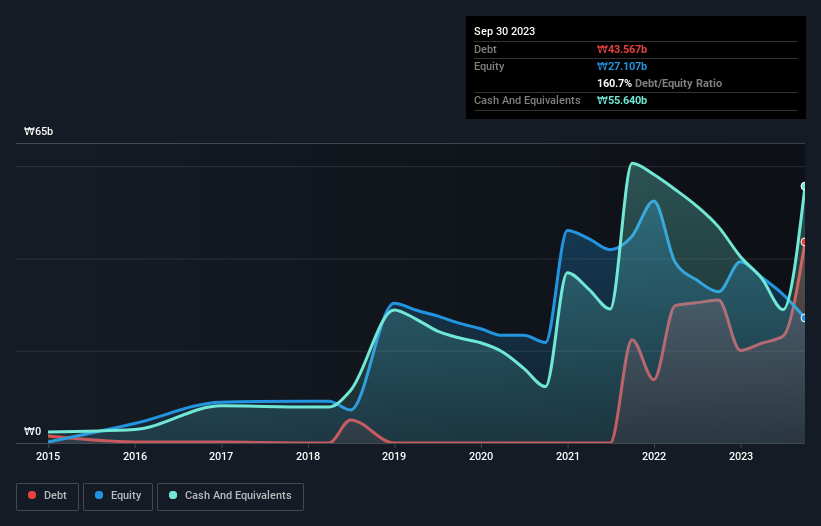Legendary fund manager Li Lu (who Charlie Munger backed) once said, 'The biggest investment risk is not the volatility of prices, but whether you will suffer a permanent loss of capital.' So it might be obvious that you need to consider debt, when you think about how risky any given stock is, because too much debt can sink a company. We can see that T&R Biofab Co., Ltd. (KOSDAQ:246710) does use debt in its business. But the more important question is: how much risk is that debt creating?
When Is Debt Dangerous?
Debt assists a business until the business has trouble paying it off, either with new capital or with free cash flow. Part and parcel of capitalism is the process of 'creative destruction' where failed businesses are mercilessly liquidated by their bankers. However, a more frequent (but still costly) occurrence is where a company must issue shares at bargain-basement prices, permanently diluting shareholders, just to shore up its balance sheet. Of course, debt can be an important tool in businesses, particularly capital heavy businesses. When we think about a company's use of debt, we first look at cash and debt together.
View our latest analysis for T&R Biofab
What Is T&R Biofab's Debt?
As you can see below, at the end of September 2023, T&R Biofab had ₩43.6b of debt, up from ₩31.0b a year ago. Click the image for more detail. But it also has ₩55.6b in cash to offset that, meaning it has ₩12.1b net cash.

A Look At T&R Biofab's Liabilities
Zooming in on the latest balance sheet data, we can see that T&R Biofab had liabilities of ₩31.5b due within 12 months and liabilities of ₩43.6b due beyond that. Offsetting this, it had ₩55.6b in cash and ₩66.3m in receivables that were due within 12 months. So its liabilities total ₩19.3b more than the combination of its cash and short-term receivables.
Since publicly traded T&R Biofab shares are worth a total of ₩150.9b, it seems unlikely that this level of liabilities would be a major threat. But there are sufficient liabilities that we would certainly recommend shareholders continue to monitor the balance sheet, going forward. Despite its noteworthy liabilities, T&R Biofab boasts net cash, so it's fair to say it does not have a heavy debt load! There's no doubt that we learn most about debt from the balance sheet. But you can't view debt in total isolation; since T&R Biofab will need earnings to service that debt. So if you're keen to discover more about its earnings, it might be worth checking out this graph of its long term earnings trend.
In the last year T&R Biofab had a loss before interest and tax, and actually shrunk its revenue by 14%, to ₩4.9b. That's not what we would hope to see.
So How Risky Is T&R Biofab?
We have no doubt that loss making companies are, in general, riskier than profitable ones. And in the last year T&R Biofab had an earnings before interest and tax (EBIT) loss, truth be told. Indeed, in that time it burnt through ₩23b of cash and made a loss of ₩18b. However, it has net cash of ₩12.1b, so it has a bit of time before it will need more capital. Overall, we'd say the stock is a bit risky, and we're usually very cautious until we see positive free cash flow. The balance sheet is clearly the area to focus on when you are analysing debt. However, not all investment risk resides within the balance sheet - far from it. These risks can be hard to spot. Every company has them, and we've spotted 3 warning signs for T&R Biofab (of which 1 is significant!) you should know about.
Of course, if you're the type of investor who prefers buying stocks without the burden of debt, then don't hesitate to discover our exclusive list of net cash growth stocks, today.
Valuation is complex, but we're here to simplify it.
Discover if T&R Biofab might be undervalued or overvalued with our detailed analysis, featuring fair value estimates, potential risks, dividends, insider trades, and its financial condition.
Access Free AnalysisHave feedback on this article? Concerned about the content? Get in touch with us directly. Alternatively, email editorial-team (at) simplywallst.com.
This article by Simply Wall St is general in nature. We provide commentary based on historical data and analyst forecasts only using an unbiased methodology and our articles are not intended to be financial advice. It does not constitute a recommendation to buy or sell any stock, and does not take account of your objectives, or your financial situation. We aim to bring you long-term focused analysis driven by fundamental data. Note that our analysis may not factor in the latest price-sensitive company announcements or qualitative material. Simply Wall St has no position in any stocks mentioned.
About KOSDAQ:A246710
T&R Biofab
Develops and commercializes various regenerative medical technologies.
Slight risk with imperfect balance sheet.
Market Insights
Community Narratives


Recently Updated Narratives


MINISO's fair value is projected at 26.69 with an anticipated PE ratio shift of 20x


The Quiet Giant That Became AI’s Power Grid


Nova Ljubljanska Banka d.d will expect a 11.2% revenue boost driving future growth
Popular Narratives


The company that turned a verb into a global necessity and basically runs the modern internet, digital ads, smartphones, maps, and AI.


MicroVision will explode future revenue by 380.37% with a vision towards success



